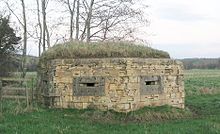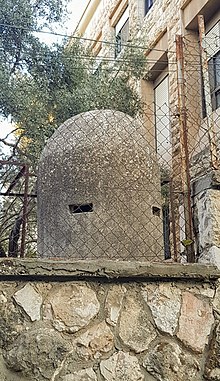Apillboxis a type ofblockhouse,or concrete dug-in guard-post, often camouflaged, normally equipped withloopholesthrough which defenders can fire weapons. It is in effect atrenchfiring step, hardened to protect against small-arms fire and grenades, and raised to improve the field of fire.


The modern concrete pillbox originated on theWestern Frontof World War I, in theGerman Army[1] in 1916.
Etymology
editThe origin of the term is disputed. It has been widely assumed to be a jocular reference to the perceived similarity of the fortifications to thecylindricalandhexagonalboxes in which medical pills were once sold; also, the first German concrete pillboxes discovered by the Allies in Belgium were so small and light that they were easily tilted or turned upside down by the nearby explosion of even medium (240mm) shells.[3]However, it seems more likely that it originally alluded topillar boxes,with a comparison being drawn between theloopholeon the pillbox and the letter-slot on the pillar box.[4]
The term is found in print inThe Timeson 2 August 1917, following the beginning of theThird Battle of Ypres;and inThe Scotsmanon 17 September 1917, following the German withdrawal onto theHindenburg Line.Other unpublished occurrences have been found inwar diariesand similar documents of about the same date; and in one instance, as "Pillar Box", as early as March 1916.[4]
Characteristics
editThe concrete nature of pillboxes means that they are a feature of prepared positions. Some pillboxes were designed to be prefabricated and transported to their location for assembly. During World War I, SirErnest William Moirproduced a design for concrete machine-gun pillboxes[5]constructed from a system of interlocking precast concrete blocks, with a steel roof. Around 1,500 Moir pillboxes were eventually produced (with blocks cast atRichboroughin Kent) and sent to theWestern Frontin 1918.[6][7]
Pillboxes are oftencamouflagedto conceal their location and to maximise the element of surprise. They may be part of a trench system, form an interlocking line of defence with other pillboxes by providing covering fire to each other (defence in depth), or they may be placed to guard strategic structures such as bridges and jetties.
Pillboxes are hard to defeat and require artillery, anti-tank weapons or grenades to overcome.
Uses
editThe FrenchMaginot Linebuilt between the world wars consisted of a massivebunkerand tunnel complex, but as most of it was below ground, little could be seen from the ground level. The exception were the concreteblockhouses,gun turrets,pillboxes andcupolaswhich were placed above ground to allow the garrison of the Maginot line to engage an attacking enemy.[8]
Between theAbyssinian Crisisof 1936 andWorld War II,the British built about 200 pillboxes on the island ofMaltafor defence in case of an Italian invasion.[9]Fewer than 100 pillboxes still exist, and most are found on the northeastern part of the island. A few of them have been restored and are cared for, but many others were demolished. Some pillboxes are still being destroyed nowadays as the authorities do not consider them to have any architectural or historic value,[10]despite heritage NGOs calling to preserve them.[11]
About 28,000pillboxes and other hardened field fortificationswere constructed in Britain in 1940 as part of theBritish anti-invasion preparations of World War II.About 6,500 of these structures still survive.[12]
Pillboxes for theCzechoslovak border fortificationswere built before World War II inCzechoslovakiain defence against a German attack. None of these were actually used against their intended enemy during the German invasion, but some were used against the advancing Soviet armies in 1945. The Japanese also made use of pillboxes in their fortifications ofIwo Jima,and on other occupied islands and territories.
About750,000 pillboxes(Albanian:bunkerët) were built by theAlbanianHoxhaist governmentfrom the 1960s until the 1980s inCold Warparanoia, most never used for their intended purpose although few were used inthe Insurrection of 1997and the1999 Kosovo Warand the construction costs were a scandalous drain on needed funds for social development.[13][14][15]Most are now derelict, though some have been repurposed asresidential accommodations,cafés,nightclubs,storehouses,cabins,animal sheltersand one inTiranaas a museum.[16][17][18][19]
During the2022 Russian invasion of Ukraine,pillboxes have been used to gain advantages intrench warfare.[20]
Gallery
edit-
A pillbox inBalaklava,Crimea.
-
Pillbox atPutney BridgeinLondon,England
-
A type 10 pillbox on theSiegfried LineinAachen,Germany
-
A square pillbox inSt Julian's,Malta
-
A camouflaged pillbox inQrendi,Malta
-
An Israeli pillbox 5.4 metres above ground,Modi'in-Maccabim-Re'ut(nearRoute 443)
-
A guard pillbox used onRobben IslandduringWorld War II
-
Exterior of a quay pillbox inIkata,Japan
-
Interior of a quay pillbox inIkata,Japan
-
Blockhouse south of Le Touquet, France. It was part of theAtlantic Wall
Notes
edit- ^
Pegler, Martin (20 August 2014).Soldiers' Songs and Slang of the Great War.Bloomsbury Publishing (published 2014).ISBN9781472809292.Retrieved22 October2021.
pill-box [:] A concrete fortification mostly used for machine guns, invented by the Germans.
- ^"Photos show Second War War pillbox on beach which has collapsed".edp24.co.uk.18 February 2021.
- ^Hellis, John."Why the name Pillbox?"Pillbox Study Group
- ^abOldham 2018
- ^"Papers on:- Machine-gun pill-box designed by Mr. E. W. Moir, Munitions Council member".National Archives of the UK.Retrieved4 December2016.
- ^Oldham 2011
- ^"Moir pillbox".South East History Boards.Retrieved4 December2016.
- ^Schneider & Kitchen 2002,p. 87.
- ^"Guided tour of WWII defences".Times of Malta.2 December 2005.Retrieved1 September2014.
- ^"Wartime pillbox at Salina being pulled down".The Malta Independent.10 April 2014.Retrieved1 September2014.
- ^Leone Ganado, Philip (30 August 2016)."WWII pillbox is not worth preserving, cultural watchdog says".Times of Malta.Archived fromthe originalon 30 August 2016.
- ^CBA staff.
- ^Obscura, Atlas (27 September 2013)."Albania's 750,000 Concrete Cold War Bunkers".Slate Magazine.Retrieved23 October2022.
- ^"Bunkers of Albania".Atlas Obscura.Retrieved23 October2022.
- ^Galjaard, David (2012).Concresco.Slavenka Drakulić, Jaap Scholten. [Netherlands?].ISBN978-94-6190-781-3.OCLC841773976.
{{cite book}}:CS1 maint: location missing publisher (link) - ^Wheeler, Tony (2007).Tony Wheeler's Bad Lands.Lonely Planet. pp.48–49.ISBN978-1-74179-186-0.
- ^Barger, Jennifer; Bellingreri, Marta (24 March 2021)."Once a state secret, these Albanian bunkers are now museums".National Geographic.Retrieved20 September2024.
- ^Taylor, Allan (13 June 2019)."The Cold War Bunkers of Albania".The Atlantic.Retrieved20 September2024.
- ^"Former nuclear bunker becomes museum of Albanian persecution".Chicago Sun-Times.20 November 2016.Retrieved20 September2024.
- ^Hernandez, Marco; Holder, Josh (14 December 2022)."Defenses Carved Into the Earth".The New York Times.ISSN0362-4331.Retrieved25 January2023.
References
edit- CBA staff,A Review Of The Defence of Britain Project,Council for British Archaeology,retrieved30 May2006[dead link]
- Hellis, John (1 June 2001)."Why the name Pillbox?".Pillbox Study Group.Retrieved10 September2009.
- Hibbs, Peter (20 April 2016)."About the Defence of East Sussex Project".pillbox.org.uk.Retrieved10 December2023.
- "pillbox, n.".Oxford English Dictionary(Online ed.).Oxford University Press.(Subscription orparticipating institution membershiprequired.)
- Oldham, Peter (2011).Pill Boxes on the Western Front: A Guide to the Design, Construction and Use of Concrete Pill Boxes, 1914–1918.Pen & Sword.ISBN9781473817227.
- Oldham, Peter (2018). "'Pill box', 'pillbox' or 'pill-box'? What's in a name? ".Stand To! The Journal of the Western Front Association.112:15–21.
- Schneider, Richard Harold; Kitchen, Ted (2002),Planning for crime prevention: a transatlantic perspective,RTPI library series, vol. 3 (illustrated ed.), Routledge, p. 87,ISBN978-0-415-24136-6– via books.google
External links
edit- Media related toPillboxesat Wikimedia Commons